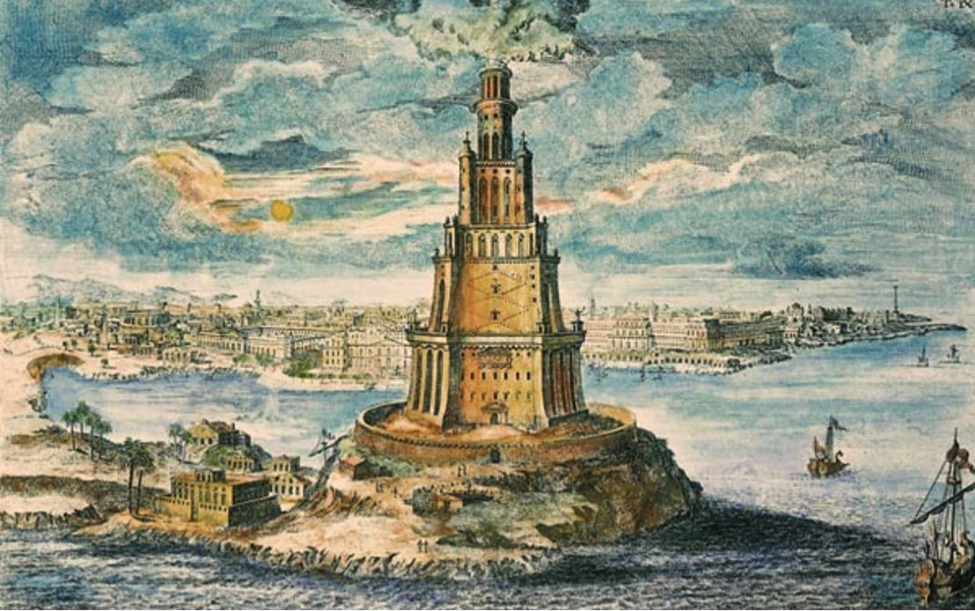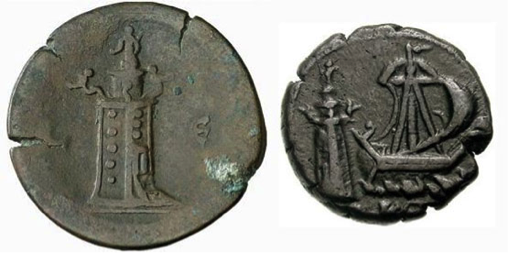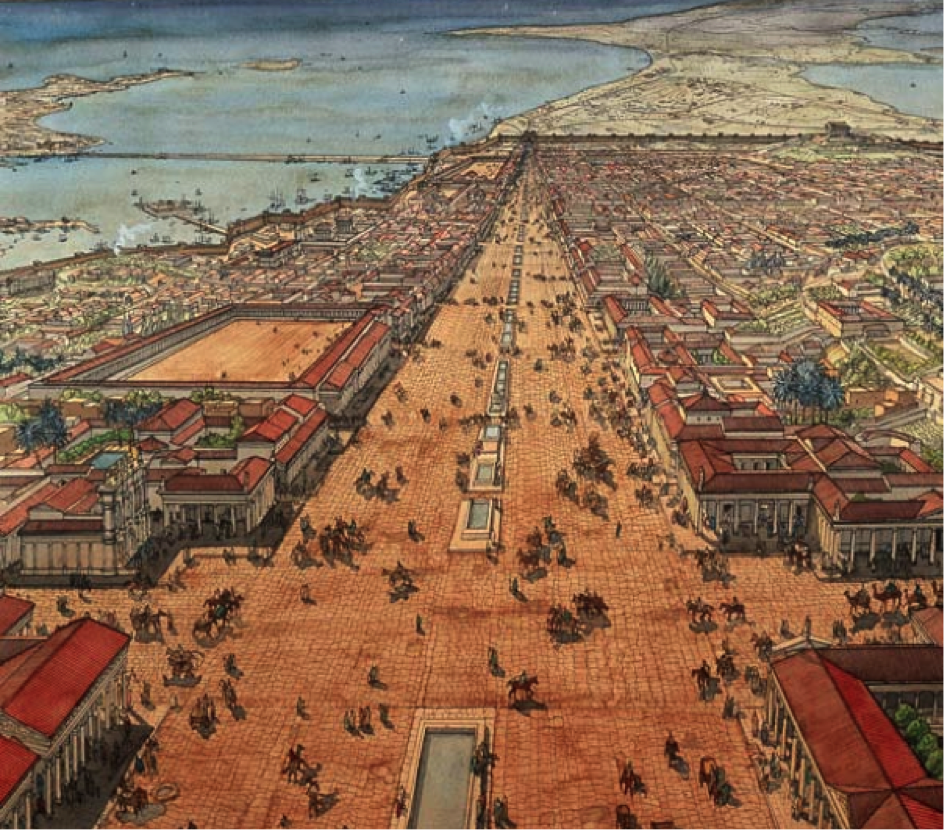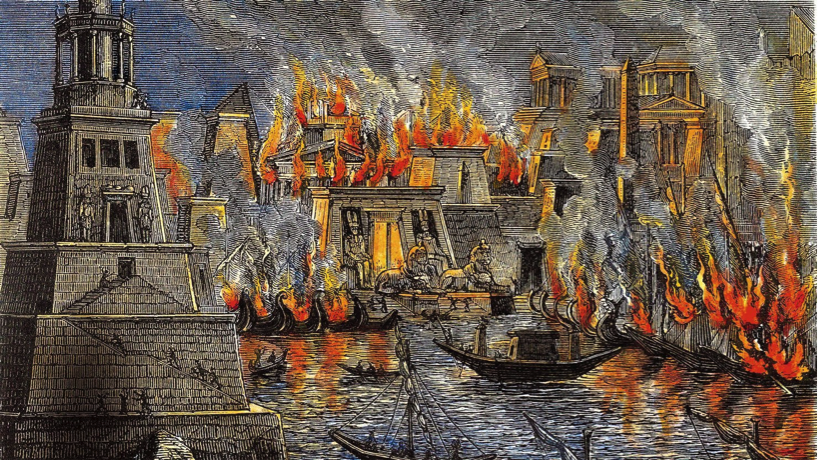By Jocelyn Hitchcock, Contributing Writer, Classical Wisdom
The Egyptian city of Alexandria was established in 331 BCE by its Eponymous founder, Alexander the Great. Despite its humble beginnings as a port city, Alexandria developed into one of the most prosperous metropolitan areas in the ancient world. It grew to boast such wonders like the library of Alexandria, the Temple of Serapis, and the Pharos of Alexandria (the lighthouse).

Foundation of Ancient Alexandria
In his “Life of Alexander,” Plutarch describes the foundation of the city Alexandria. After Alexander the Great’s conquest of Egypt, which was part of his campaigns all over the eastern Mediterranean, he planned to settle a large Greek city, “which would bear his name.” Alexander had imagined a city that would be home to men of all nations, and one that would abound in resources. Cleomenes, Alexander’s commander, was left in charge of the construction and expansion of the city. Following in Cleomenes’ footsteps, Ptolemy further built up the city and subsequently his own familial dynasty ruled Egypt from 332-30 BCE.

Alexandria’s Rise to Prominence
Since Alexandria came to replace the previous Egyptian capital of Memphis, and Tyre, a significant port city, was destroyed by Alexander, the new capital filled a vacuum of both political and commercial means. Alexandria became a lucrative node in the trade network of the Mediterranean, and attracted commerce from the east, north, and west.
This allowed for the local economy to prosper, which in turn led to investments in institutions like the Library of Alexandria. The city was known for attracting scientists, philosophers, artists, and mathematicians (like Euclid!)
This allowed for the local economy to prosper, which in turn led to investments in institutions like the Library of Alexandria. The city was known for attracting scientists, philosophers, artists, and mathematicians (like Euclid!)

Institutions of Alexandria
Of course, one of the most famous products of Alexandria is the library. It was one of the most ambitious projects not only of the ancient world, but even by today’s standards. The Library of Alexandria aimed to collect all the knowledge of the world and house it in a single place. Ptolemy I began work on the library and located it in the royal district of the city. No doubt modeled in grand fashion, we have no surviving accounts of the architecture and can only speculate as to its appearance. With the intent of the library being to collect a copy of every book in the world, it is no surprise that Ptolemy II instituted a practice that required every ship docking at the port to hand over any books on board to be copied out for the collection.
Unfortunately, this gold mine of science, history, math, and literature was destroyed. As the city of Alexandria changes rule several times throughout its history, the new governing body viewed the Library of Alexandria as a threat to their control rather than a fountain of information. The use of the library waned over the years and its reported that several periods of fire took place, destroying scrolls and manuscripts.
Another prominent installation of Alexandria at her height of power was the Serapeum. The temple, which was constructed under Ptolemy III in the 3rd century BCE, was dedicated to the protector of Alexandria, Serapis. Strabo tells us that the temple was housed in the western portion of the city. Like the Library of Alexandria, the Serapeum does not survive and we can only assume what it looked like.

However, an article discussing Alexandria would be remiss if it did not include a discussion of the lighthouse of Alexandria. Considered one of the seven wonders of the ancient world, it became the model of lighthouses then and now. The lighthouse, or Pharos, served as a practical component of Alexandria, helping guide ships into her harbors; but it also was a feat of technology, reaching a staggering height and becoming a symbol of the city, as we can see on coin depictions.

Roman Alexandria
With the Roman victories in the Punic Wars, Rome reigned supreme in the Mediterranean and Alexandria came under her rule. For roughly two centuries, this didn’t impact the prosperity of Alexandria too terribly much. She still continued to be a prominent port city with a bustling social sphere. It was during the breakdown of the First Triumvirate, though, that we see direct negative sanctions being placed on Alexandria. Pompey’s loss to Caesar in the Battle of Pharsalus led to his flight to Alexandria, seeking sanctuary. However, he was killed by Ptolemy XIII and Caesar arrived, declaring martial law of the land. In the following years of civil war between Cleopatra and Ptolemy, the city of Alexandria suffered destruction and fires.
After the death of Cleopatra and Marc Antony, and the consolidation of power by Augustus, Alexandria became a province of the Roman Empire, lacking any real political autonomy. The city was rebuilt after the fires and recovered from the internal turmoil of the 1st century BCE, but never quite to the level of pre-Roman occupation.

Decline of Alexandria
Having been such a hot bed for knowledge, learning, and advancements for centuries, Alexandria’s involvement in the Christianity vs. paganism schism does not come as a surprise. Still under Roman rule, Theodosius I outlawed paganism, promoting instead the conversion to Christianity. As Alexandria had been a prosperous and robust city for centuries, temples, sanctuaries, and monuments reflecting the newly outlawed religion abounded. Christians of the city clashed with pagans in Alexandria and the city plunged into religious and ideological distress. Scholars that had once felt safe, encouraged, and supported now fled the city in search of calmer surroundings. The draw of Alexandria as a cultural, political, and commercial center no longer persisted due to the constant religious tension and the city fell by the wayside.
The city of Alexandria certainly had an active history, serving as the stage for political rivalries, scholastic breakthroughs, and religious wars. The longevity of the city’s occupation allowed her to be involved in several events of the wider Mediterranean. Of course, we all dream about what could have been if only the Library of Alexandria were still around today.










No comments yet. You should be kind and add one!
Our apologies, you must be logged in to post a comment.